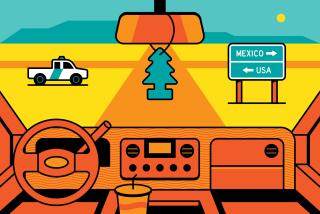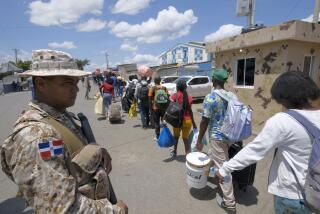South American Countries Bordering on Battle Over National Boundaries : Geography: Lines that were drawn when nations gained freedom in the 19th Century have been disputed ever since. Most of the squabbles are verbal, but occasionally fighting breaks out.
- Share via
High in the Andes, a giant bronze statue of Christ looks down on Chile and Argentina. Erected in 1904 as a symbol of good will between neighbors that long had squabbled about their border, it bears the inscription:
“Sooner shall these mountains crumble into dust than the peoples of Argentina and Chile break the peace which at the feet of Christ the Redeemer they have sworn to maintain.”
The Andes, of course, have not crumbled. But, although Argentina and Chile have not broken their peace, they have come close and still do not agree on all the zigs and zags of their 2,900-mile border.
And so, besides symbolizing friendship, Christ of the Andes is a reminder of fragile boundaries that can produce tension, arms buildups, economic damage, nationalistic fervor and occasional wars throughout Latin America.
“Look at a map of South and Central America, pick any countries that come together, and chances are they’ve had a border dispute since gaining independence in the 19th Century,” said Jack Child, a Latin American expert at American University in Washington, D.C.
Most of the battles are verbal--though they can rise to an angry pitch--sometimes involve weapons and leave a bitter legacy.
South America’s most famous internal quarrel--Argentina’s 1982 war with Great Britain wasn’t a border dispute--involves Chile, Peru, Bolivia and a chunk of coastline in what is now northern Chile but used to be Peru and Bolivia.
When those three nations gained independence, that land was of little use except as Bolivia’s outlet to the Pacific Ocean.
Valuable nitrate fertilizers were then discovered in the area. Chile, seeking to improve its troubled economy, attacked Bolivia’s coastal province in 1879. Peru came to Bolivia’s aid, and the War of the Pacific began.
Four years later Chile had won an overwhelming victory. It annexed about 60,000 square miles of its foes’ territory, humiliated Peru by occupying Lima and left Bolivia landlocked.
Fears of conflict arose again in the 1970s, but the saber-rattling eventually subsided.
Bolivia, still suffering the economic and emotional consequences of being landlocked, stages an annual Day of the Sea.
On a more practical level, Bolivia continues to bring its claim before the Organization of American States and holds bilateral negotiations with Chile.
Experts cite several reasons for the still-simmering quarrels and concerns over borders in Latin America:
* Colonial regimes didn’t know much about the region’s geography and imposed arbitrary, unrealistic frontiers.
* When boundaries were originally drawn, not much was at stake. This changed as valuable minerals were found, populations grew and pressures for expansion increased.
* It is very hard to delineate precise borders when they run through rugged mountains, dense jungle and meandering rivers.
This is one reason why Argentina and Chile are still at odds. They thought they had settled matters with an 1881 treaty providing that the frontier would run along the highest peaks of the Andes, which were assumed to be the continental divide. All land draining westward to the Pacific Ocean was to belong to Chile; everything draining eastward to the Atlantic, to Argentina.
Trouble arose later when it was discovered that the highest peaks were not always the watershed points. After decades of negotiations, 23 of 24 disputed spots have been settled, and a tribunal of arbiters from five Latin American countries is being asked to solve the final one.
A more serious Argentine-Chilean dispute arose over three islands in the Beagle Channel off the tip of South America. The two nations were on the brink of war in 1978 before Pope John Paul II intervened as a mediator.
Another “Where’s the border?” controversy involved the United States. After an 1864 flood, the Rio Grande River, separating the United States and Mexico, cut a new channel between El Paso, Tex., and its Mexican sister city, Ciudad Juarez. About 630 acres that had been part of Ciudad Juarez suddenly were on the river’s northern bank, in El Paso.
International arbitration determined that the disputed territory, called El Chamizal, “the thicket,” should be returned to Mexico. But not until 1964 did the United States rectify matters.
Although all Latin American borders are now quiet, no one predicts an end to squabbling.
More to Read
Sign up for Essential California
The most important California stories and recommendations in your inbox every morning.
You may occasionally receive promotional content from the Los Angeles Times.













